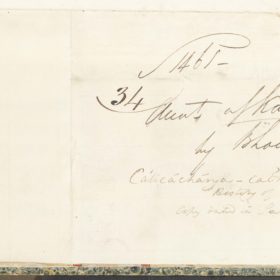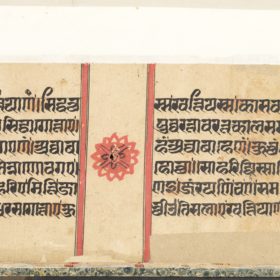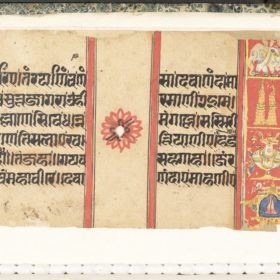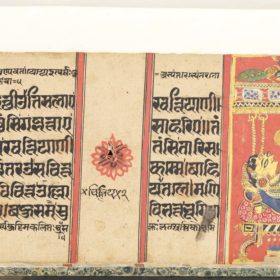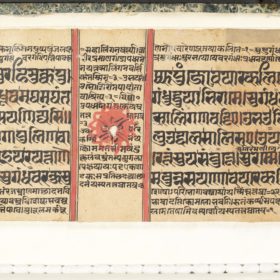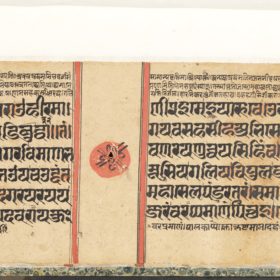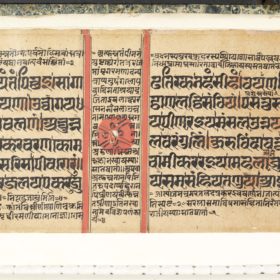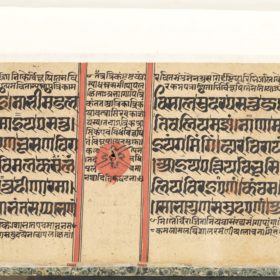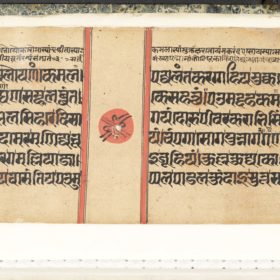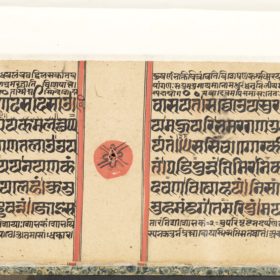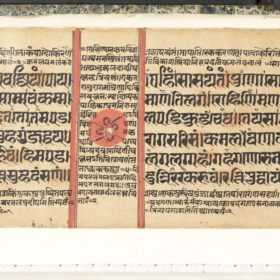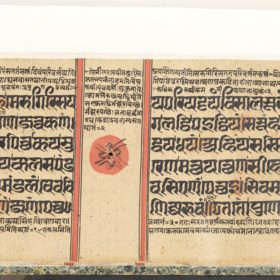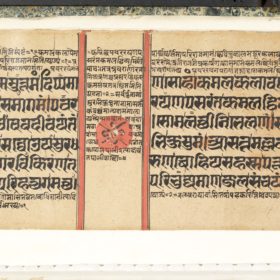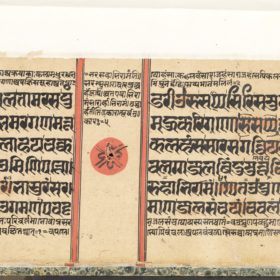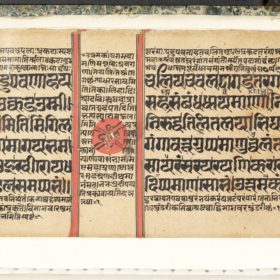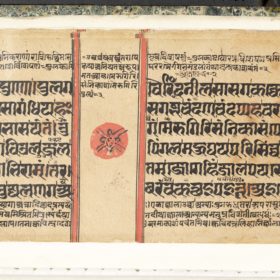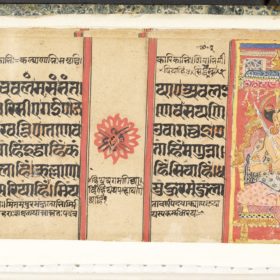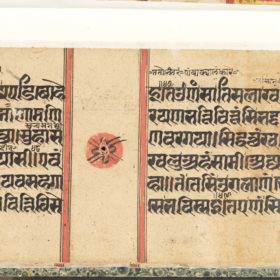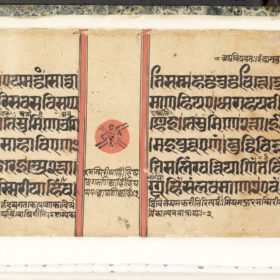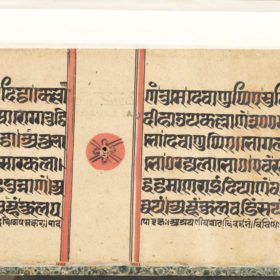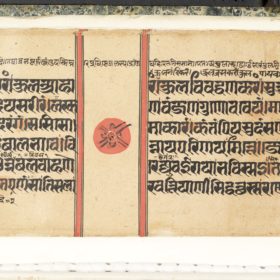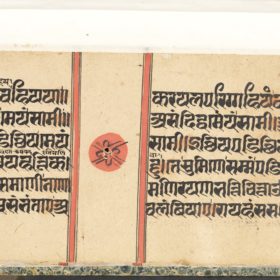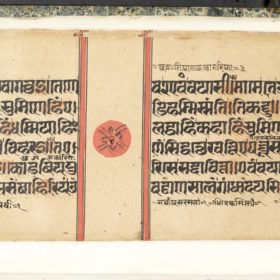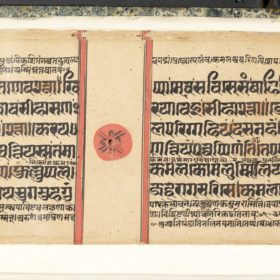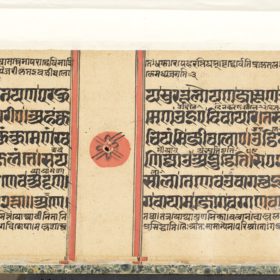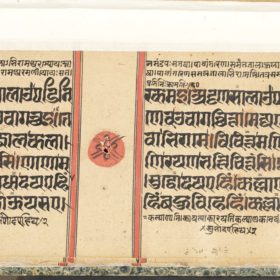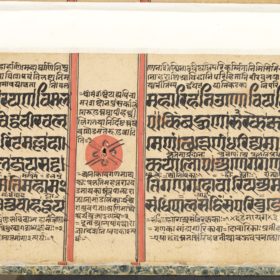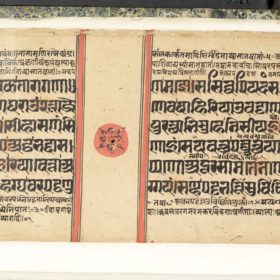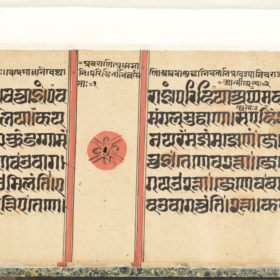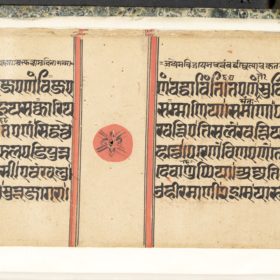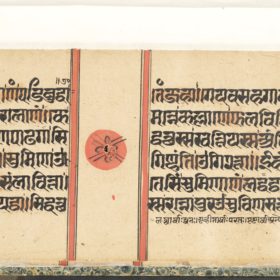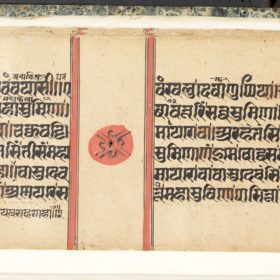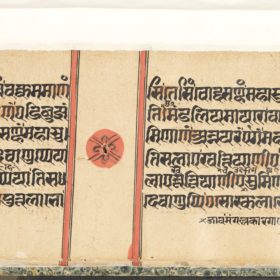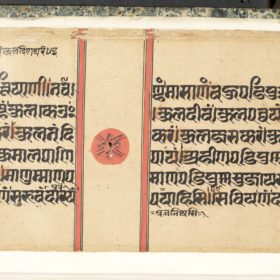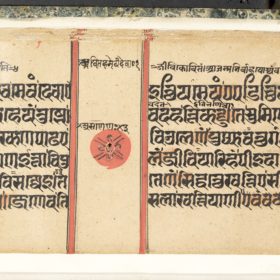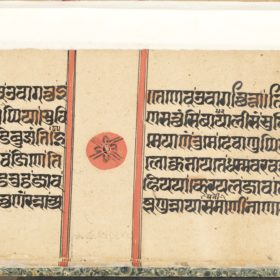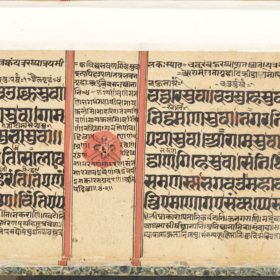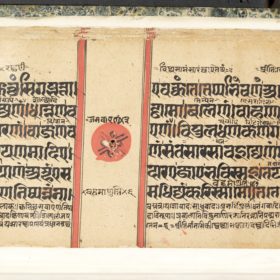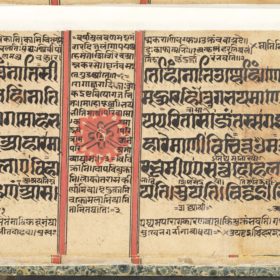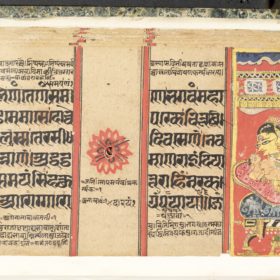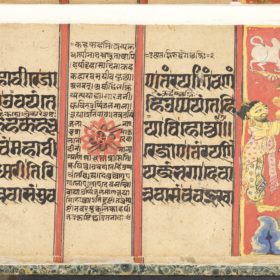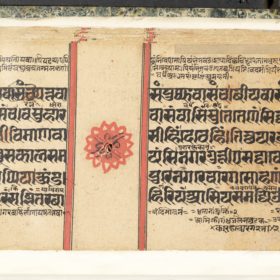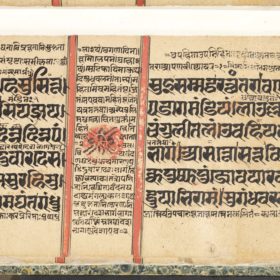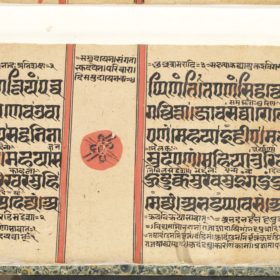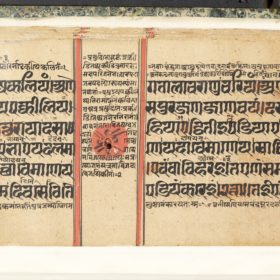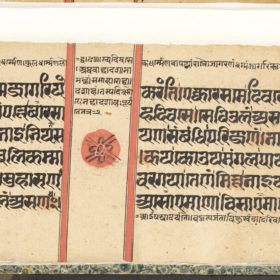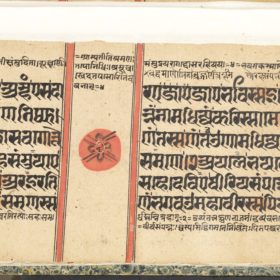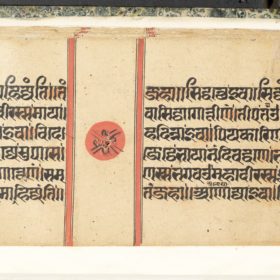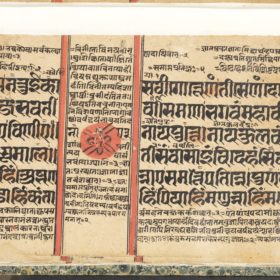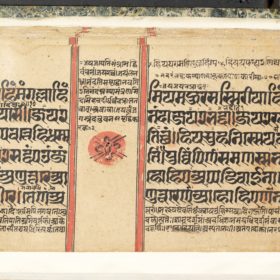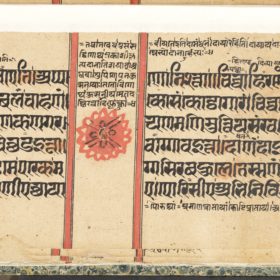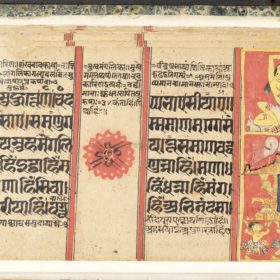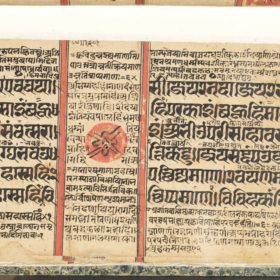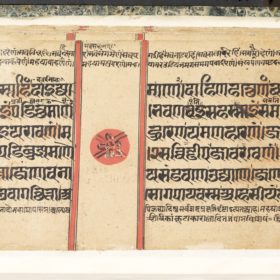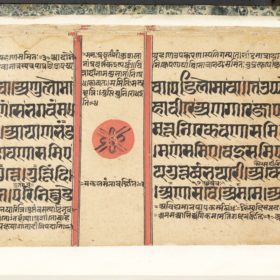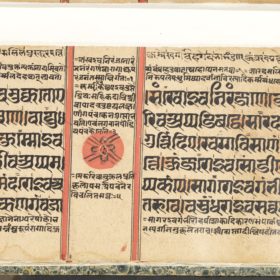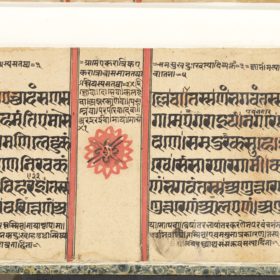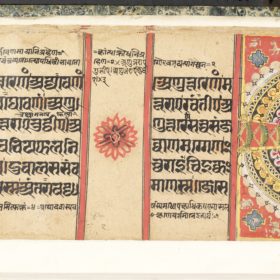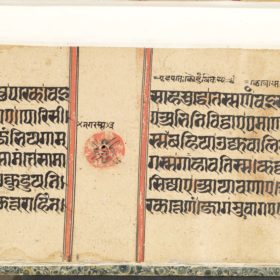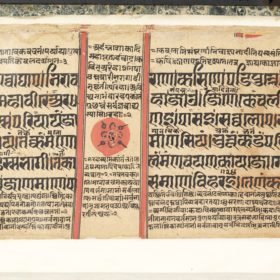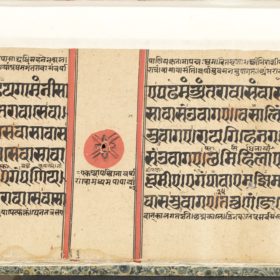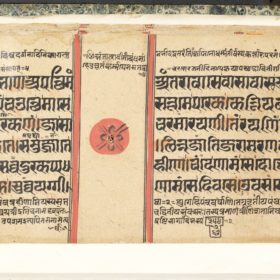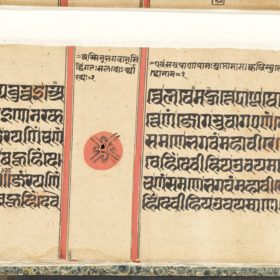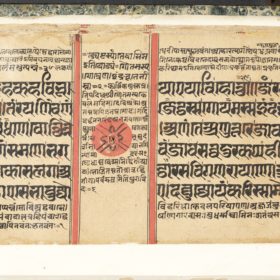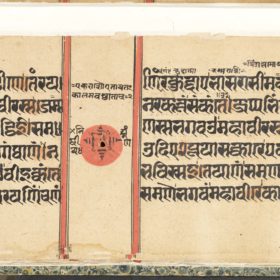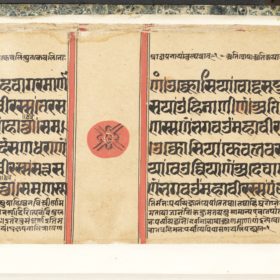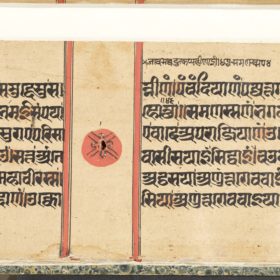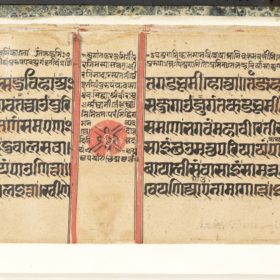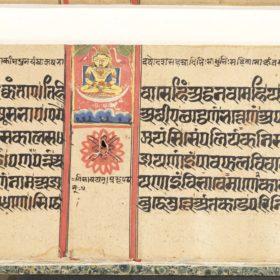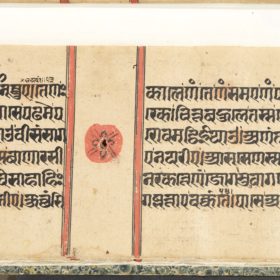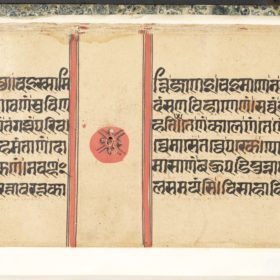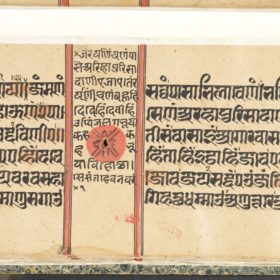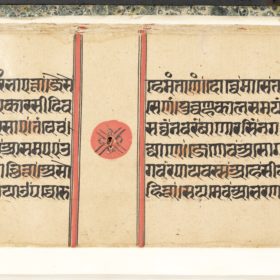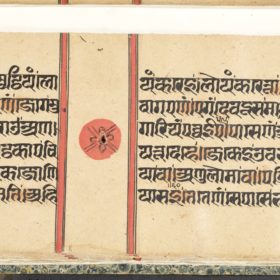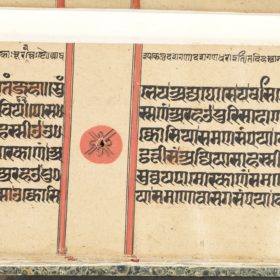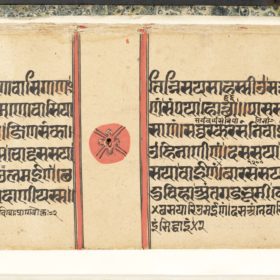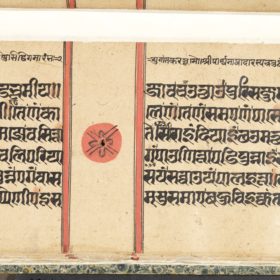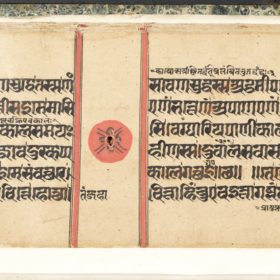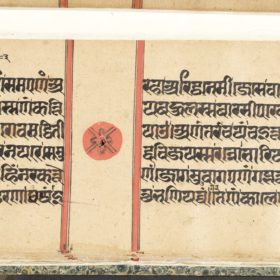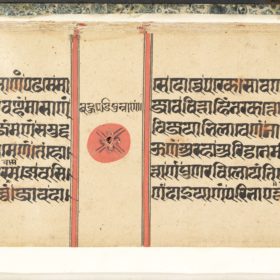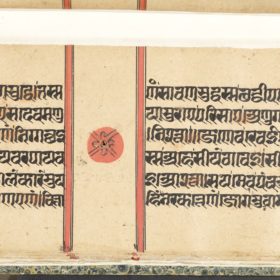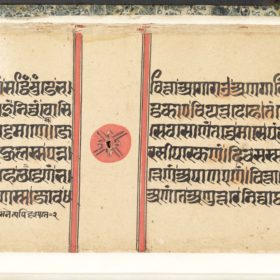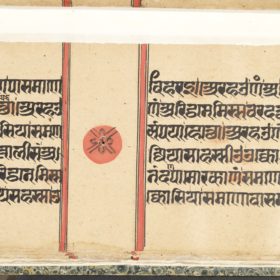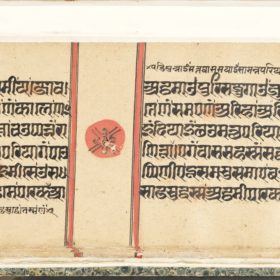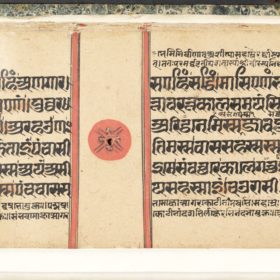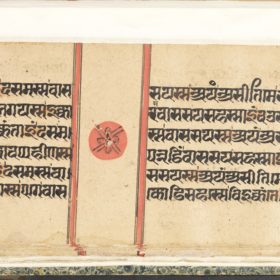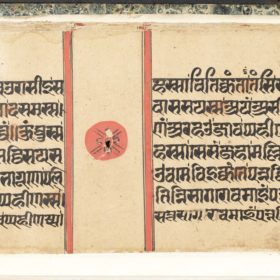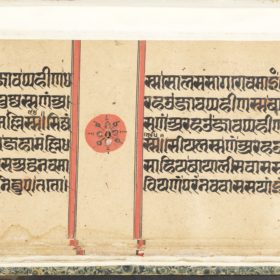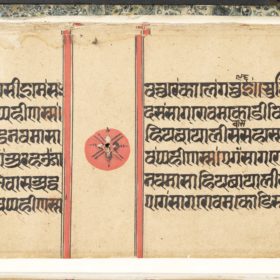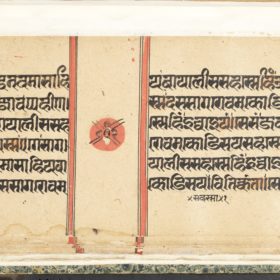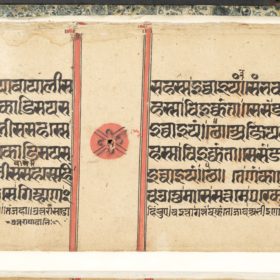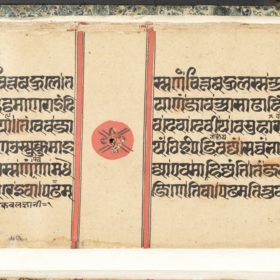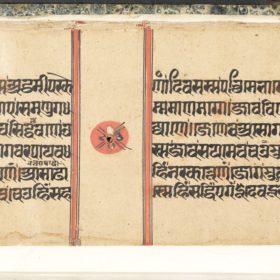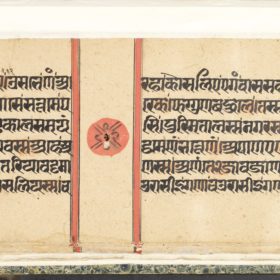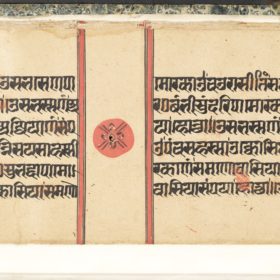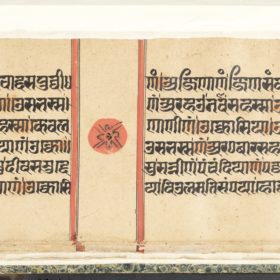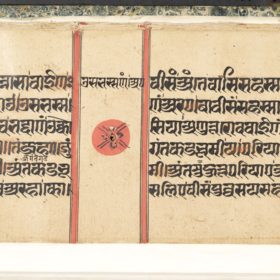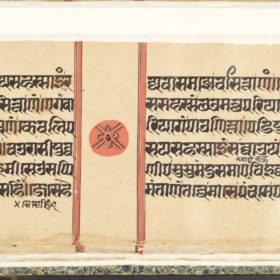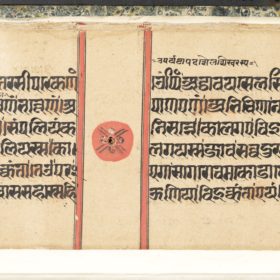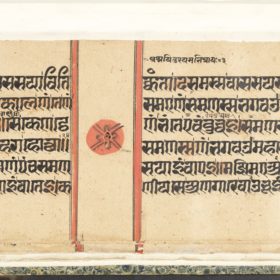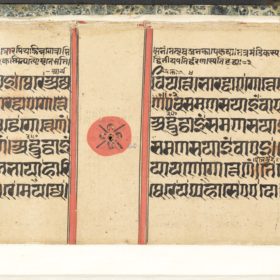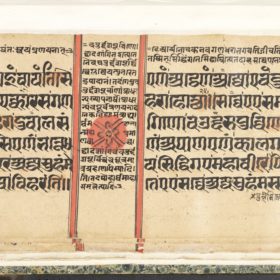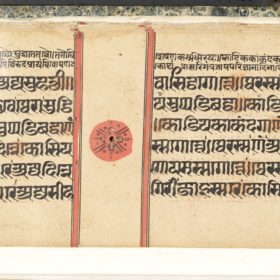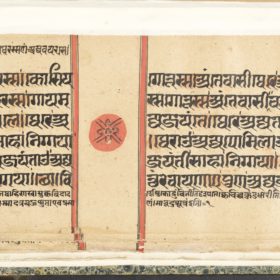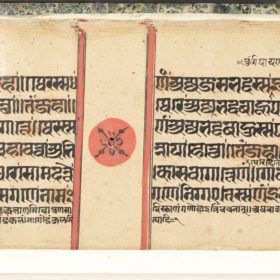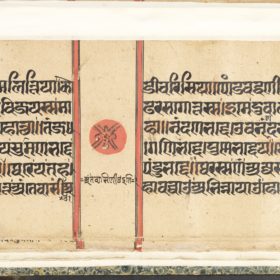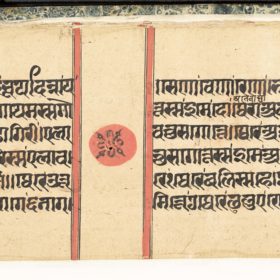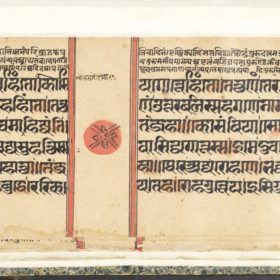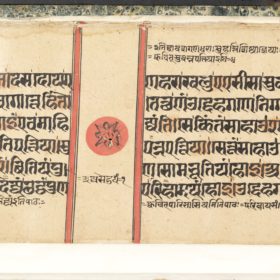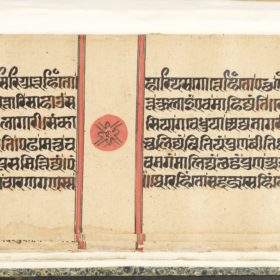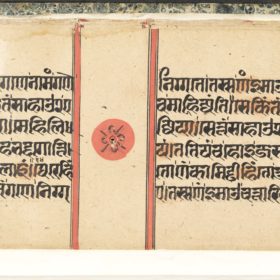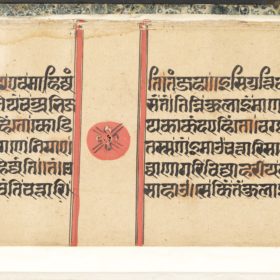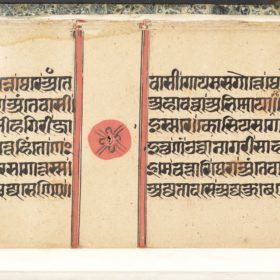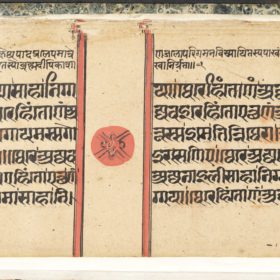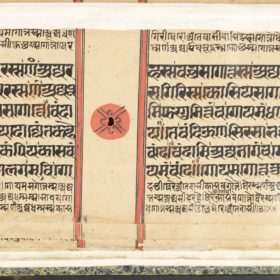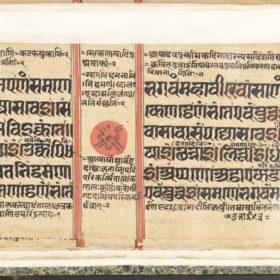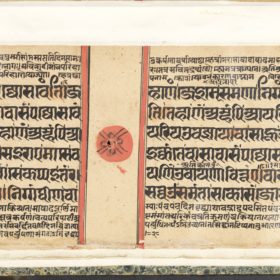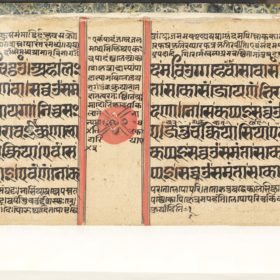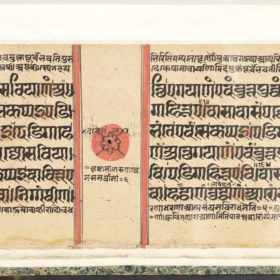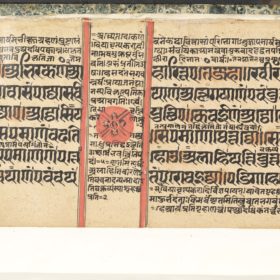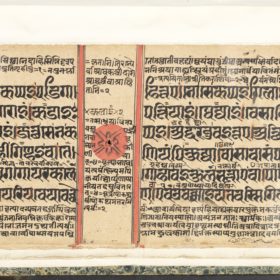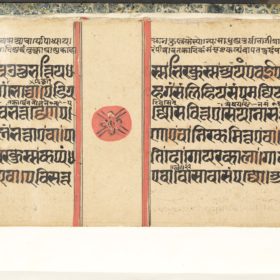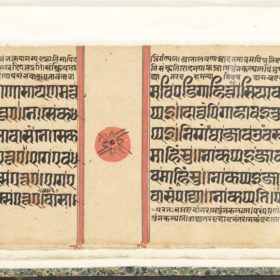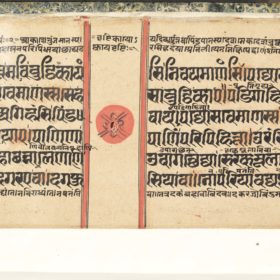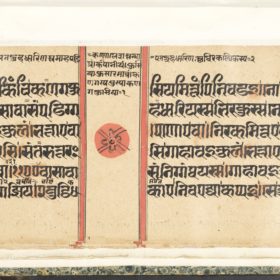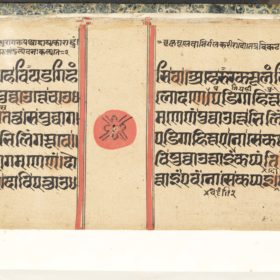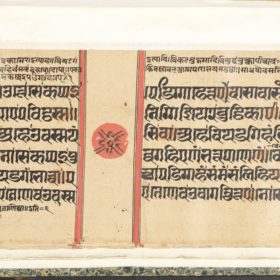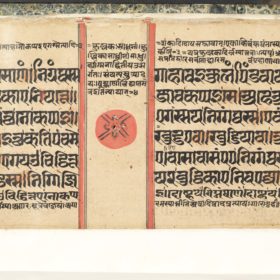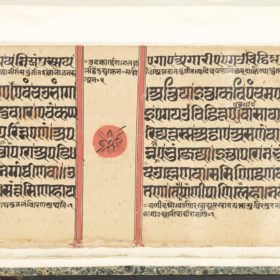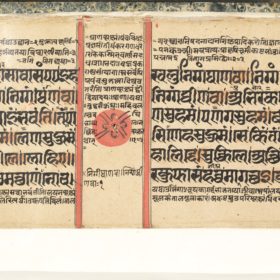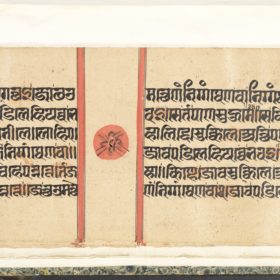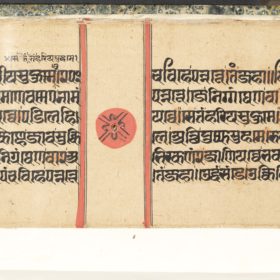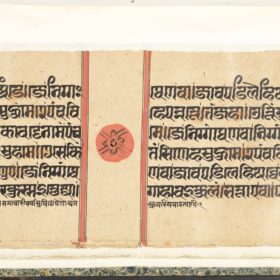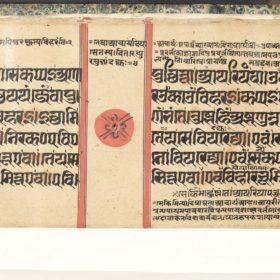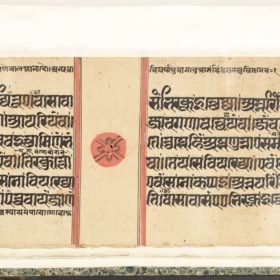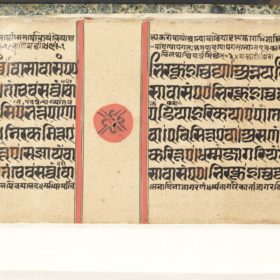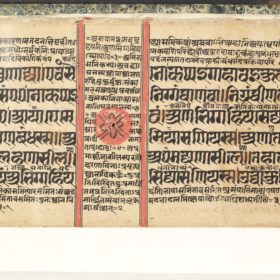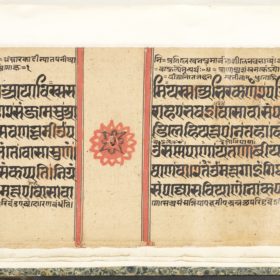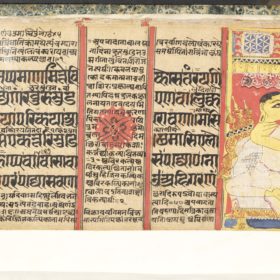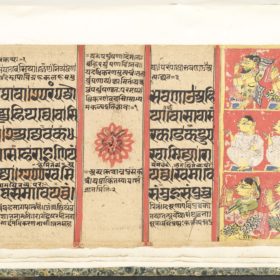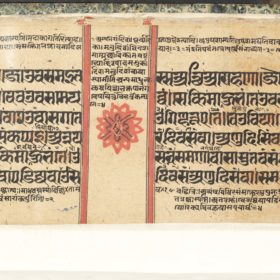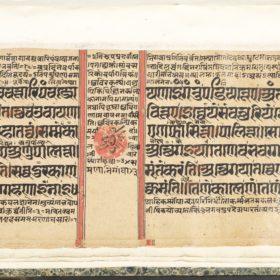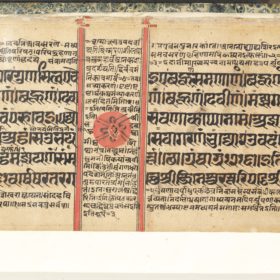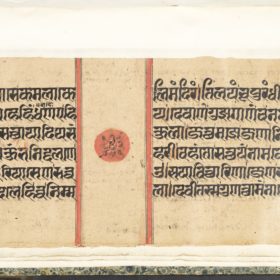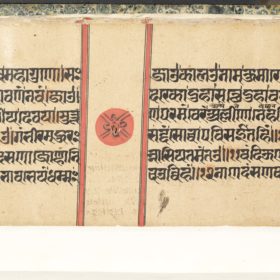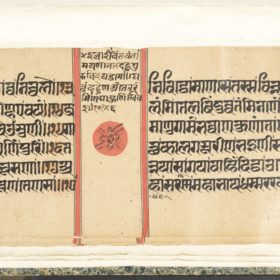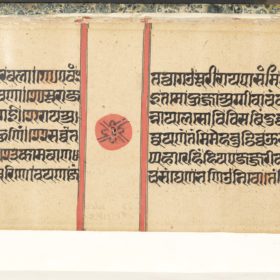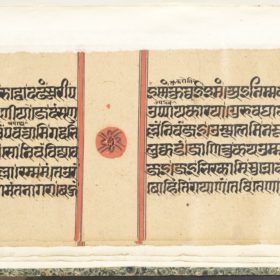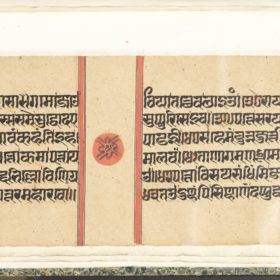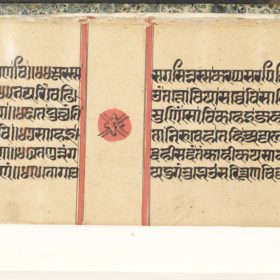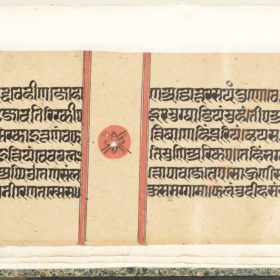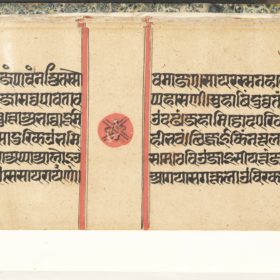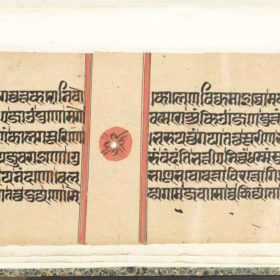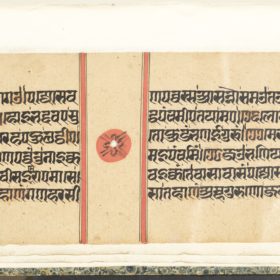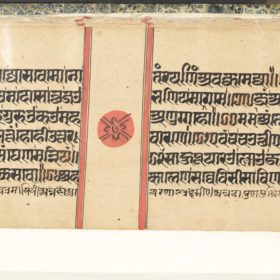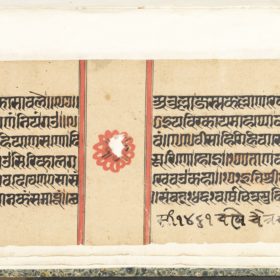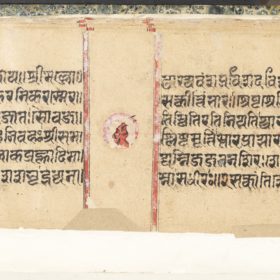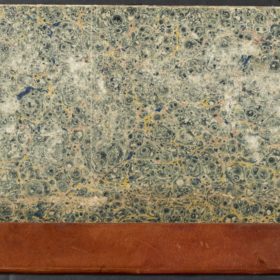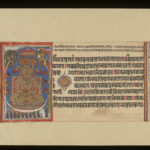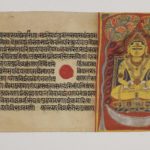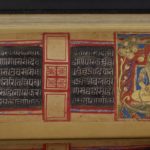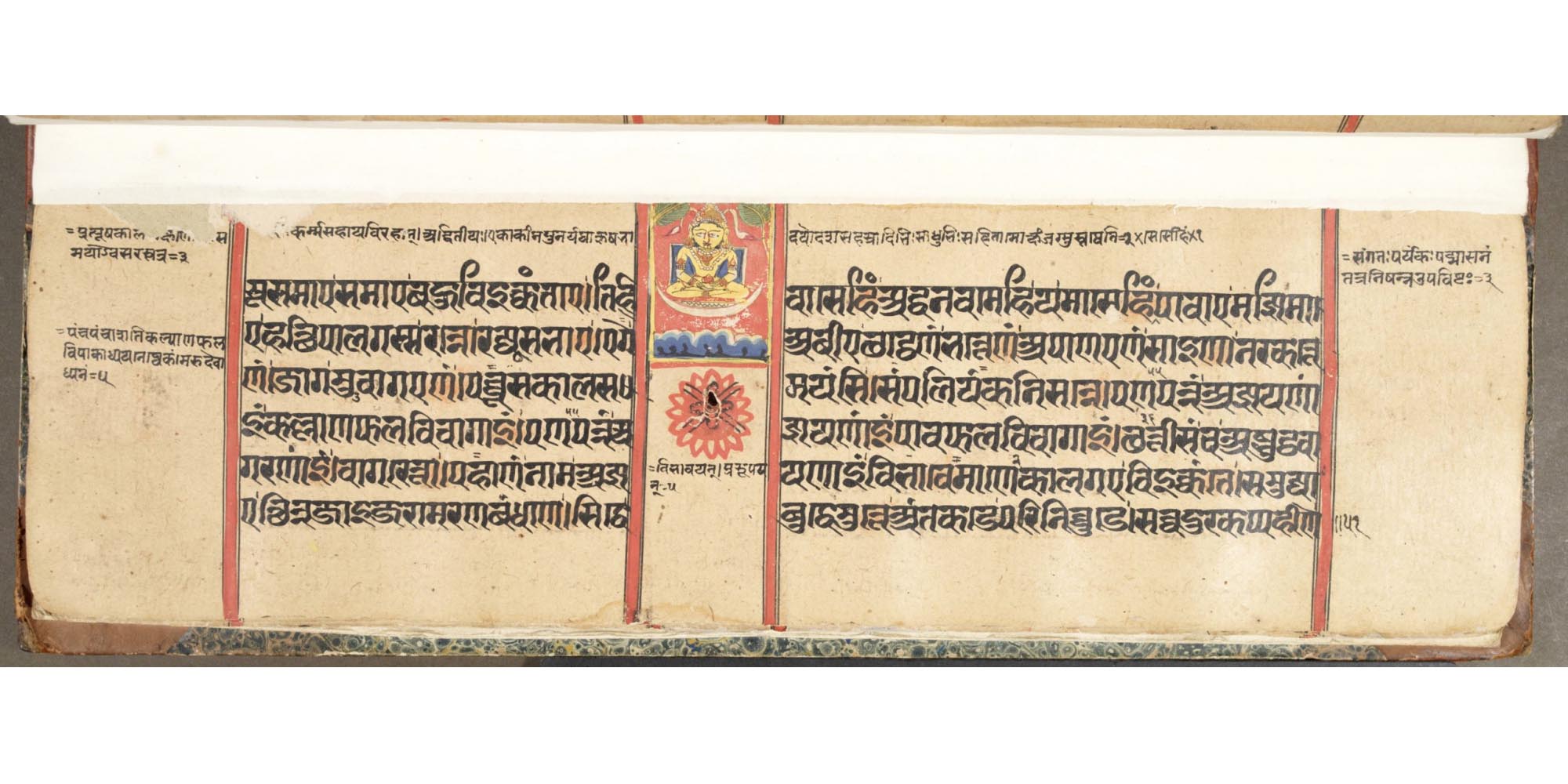
Background
This passage of the Kalpa-sūtra provides information of various kinds.
First, it refers to the town of Pāvā as the place where Mahāvīra died. Pāvāpurī is one of the most important sacred places for Jains because of this association.
Secondly, Mahāvīra’s pure state of mind at the time of death is underlined by his vow to keep a fast and by the fact that he was meditating and studying at that point.
Finally, two of the scriptures that are part of the Śvetāmbara canon are mentioned. These are the:
- Vipāka-sūtra, which is the last of the Aṅgas
- Uttarādhyayana-sūtra, the name of which means ‘additional’ or ‘coming at the end’.
A Jina is always shown in meditation, either standing or sitting, like here. Among the Śvetāmbaras, the Jina is thought of as a spiritual king and is often depicted with ornaments and pictured seated on a throne.
The Kalpa-sūtra is the most frequently illustrated Jain text of the Śvetāmbara sect. It is read and recited by monks in the Śvetāmbara festival of Paryuṣaṇ, which takes place in August to September each year.
The first part of the Kalpa-sūtra deals with the lives of the Jinas, especially Mahāvīra, Pārśva, Nemi and Ṛṣabha. It features almost identical stories of their births, lives as princes, renunciation, enlightenment and final emancipation.The second part – Sthavirāvali – is a praise of the early teachers of Jainism. The third part – Sāmācārī – deals with particular monastic rules to be followed during the rainy season.
The author, or authors, of the Kalpa-sūtra is unknown, although it is attributed to Bhadrabāhu. Manuscripts of the Kalpa-sūtra frequently contain a related text at the end, called the Kālakācārya-kathā. The Story of the Monk Kalaka provides an explanation of the date of the festival of Paryuṣaṇ, in which the Kalpa-sūtra features. The version in this manuscript is by Bhavadeva-sūri.
Transcription
1. sūsamāe samāe bahu-viikkaṃtāe / tihi vāsehiṃ addhanavamehi ya māsehiṃ Pāvāe majjhimā-
2. e Hatthipālagassa ranno rajjū-sabhāe / ege abīe chaṭṭheṇaṃ bhatteṇaṃ apāṇaeṇaṃ Sāiṇā nakkhatte-
3. ṇaṃ jogam uvāgaeṇaṃ / paccūsa-kāla-samayaṃsi saṃpaliyaṃkaṃ nisanne paṇapannaṃ ajjhayaṇā-
4. iṃ kallāṇa-phala-vivāgāiṃ / paṇapannaṃ ajjhayaṇāiṃ pāva-phala-vivāgāiṃ / chattīsaṃ ca apuṭṭha-vā-
5. garaṇāīṃ / vāgarettā / pahāṇaṃ nāma ajjhayaṇāiṃ vibhāvemāṇe (2) kāla-gae viikkaṃte samujjā-
6. e chinna-jāi-jarā-maraṇa-baṃdhaṇe siddhe buddhe mutte aṃtakaḍe parinivvuḍe / savva-dukkha-ppahīṇe // 51.
Translation
When in the descending era the greater part of the Duḥṣama-suṣamā period had elapsed and only three years and 8½ months were left, in the town of Pāpā, and in King Hastipāla’s office of the writers, [Mahāvīra] single and alone, [was] observing a vow of taking food devoid of water once every third day, when the moon was in conjunction with the constellation Svāti, at the time of early morning, seated in lotus posture, [and then after] having explained the 55 lectures on the outcome of good acts and the 55 lectures on the outcome of bad acts [= reference to the Vipāka-sūtra], and the 36 unasked questions [= reference to the Uttarādhyayana-sūtra], as he was concentrating on the chapter Pradhāna, [he] passed away, went beyond the bounds of karma, was uplifted after having left the world, cut asunder the tie of birth–old age–death, and became perfected, enlightened and liberated, the maker of the end, and the terminator of all misery.
Translation by Jacobi 1895: 269 and Lalwani 1979: 76–77, with changes
Glossary
Description
On this page, the illustration is not full size and does not occupy the right-hand side of the page as in other cases in this manuscript. Instead, it is a small vignette in the middle margin.
A male figure in an elaborate headdress sits in the lotus posture of meditation. Below him is a large white crescent moon. A double-ended lotus stalk droops from his headdress. Mountain peaks are shown beneath him.
These mountains represent a natural landscape while the lotus flower symbolises spiritual purity. The figure is the 24th Jina Mahāvīra, who has died and reached emancipation. This state is represented by the crescent, which symbolises the siddha-śilā. This is the area at the top of the Jain universe where a liberated soul goes directly after leaving the body. There it enjoys perfect bliss and omniscience.
This is the standard way of illustrating the final emancipation. The peculiar headdress and the serene facial expression are characteristic of such scenes. The perfect happiness and power characterising a liberated soul – siddha – are considered close to that of royalty so Mahāvīra is shown adorned.
Other visual elements
In many Kalpa-sūtra manuscripts, there is a clear intention to make the manuscript a valuable and remarkable object in itself. Here this is achieved in a rather modest manner. This aim is signalled by the:
- ornamental motif in the central margin
- calligraphic script.
This manuscript belongs to a rather early phase of Kalpa-sūtra paper manuscripts, the beginning of the 15th century. This is evidenced by the:
- format of the paper, which is rather narrow
- old system of folio numbering, using 'letter-numerals', which is visible in the left-hand margins of verso pages.
Script
The elaborate script is the Jaina Devanāgarī script, in a form which recalls calligraphy. It is used for writing numerous Indian languages, here for Ardhamāgadhī Prakrit and Sanskrit.
This manuscript was read after it was copied and this page shows additions in smaller script, namely:
- in line 3, the small number 55 added above the line is the translation into numbers of the Prakrit word paṇapannaṃ – ‘55’
- at the end of line 4, the small number 36 above the line is the translation into numbers of the Prakrit word chattīsaṃ – ‘36’
- in the margin of line 6, the number 51 stands for 151 and is the paragraph number.
In many manuscripts the paragraph numbers are part of the text, but here they have been added afterwards.
The lines in smaller script above and below the main text and in the margins are explanations in Sanskrit of phrases found in the central part. The two small parallel lines like slanted = after the words are meant to separate the explanations in the margins. The parallel lines around words in the text indicate which words are glossed. On this page they are not very numerous.
- Source:
Royal Asiatic Society
- Shelfmark:
Tod MS 34
- Author:
unknown author / Bhavadeva-sūri
- Date of creation:
1404
- Folio number:
59 recto
- Total number of folios:
97 folios, numbered 16 to 112, with 1–15 missing
- Place of creation:
western India
- Language:
Prakrit and Sanskrit
- Medium:
ink and watercolour on paper
- Size:
32.5 x 9.4 cm
- Copyright:
Royal Asiatic Society Images/RAS, London
- Image Copyright:
- +
- aAbhavya
- aAbhinandana
- aAbhiṣeka
- aĀcāra
- aĀcārāṅga-sūtra
- aĀcārya
- aAchalbhrata
- aAḍhāī-dvīpa
- aAdharma
- aAdho-loka
- aAdhyayana
- aAdvaita Vedānta
- aĀgama
- aAghātīya
- aAghātīya-karman
- aAgnibhuti
- aAgra
- aĀhāra
- aAhiṃsā
- aAhimsa Day
- aAjita
- aAjīva
- aAkampit
- aĀkāśa
- aAkbar the Great
- aAkṣaya-tṛtīyā
- aAlauddin Khalji
- aAlbert Einstein
- aAllah
- aAlms
- aĀlocanā
- aAloka-ākāśa
- aAmāri
- aAmbikā or Kūṣmāṇḍinī
- aAnagāra
- aAnanta
- aAnarthadaṇḍa
- aAnaśana
- aAnekānta-vāda
- aAṅga
- aAniconism
- aAnojjā
- aAntarāla
- aAntarāya-karma
- aAṇu
- aAṇu-vrata
- aAnukampā
- aAnuprekṣā
- aAnusvāra
- aApabhraṃśa
- aAparigraha
- aAra
- aĀrambha
- aĀrambhaja
- aĀratī
- aArdhamāgadhī Prākrit
- aArhaṃ
- aArhat
- aArśana-āvaraṇīya-karma
- aĀrta-dhyāna
- aĀryikā
- aĀryikā Jñānamati
- aĀśātanā
- aĀścarya
- aAscetic
- aAsceticism
- aAshram
- aAspiration
- aĀsrava
- aAṣṭa-maṅgala
- aAṣṭāpada
- aAstikāya
- aAstrolabe
- aAsura
- aAtheism
- aAticāra
- aAtiśayakṣetra
- aAtithisaṃvibhāgavrata
- aĀtma-vāda
- aĀtman
- aAuṃ
- aAurangzeb
- aAuspicious
- aAusterity
- aAvadhāna
- aAvadhi-jñāna
- aĀvaraṇī-yakarman
- aAvasarpiṇī
- aAvatāra
- aAvidyā
- aAxiom
- aĀyāga-paṭa
- aĀyambil
- aĀyu-karma
- aĀyurveda
- bBabur
- bBāhubali
- bBaladeva
- bBālāvabodha
- bBandha
- bBasadi
- bBazaar
- bBhadrankarvijay
- bBhagavant
- bBhaktāmara-stotra
- bBhakti
- bBhale
- bBharata
- bBhāṣā
- bBhāṣya
- bBhaṭṭāraka
- bBhāva
- bBhāva-pūjā
- bBhāvanā
- bBhavana-vāsin
- bBhavya
- bBhavyatva
- bBhaya
- bBhoga-bhūmi
- bBhogopabhoga
- bBodhi
- bBollywood
- bBrahmā
- bBrahma-deva
- bBrahmacārī
- bBrāhmaṇa
- bBraj Bhāṣā
- bBright fortnight
- bBritish Raj
- bBuddha
- bBuddhi-sagar
- bBuddhism
- bBuddhist
- cCaitya
- cCaityavāsin
- cCakravartin
- cCakreśvarī
- cCāmara
- cCandanā
- cCandragupta
- cCandraprabha
- cCanon
- cCāritra
- cCāritramohanīya-karman
- cCarũrī
- cCaste
- cCaturvidha-saṅgha
- cCaturviṃśati-stava
- cCāturyāma
- cCE
- cCelibacy
- cCha
- cChadmastha
- cChastity
- cCheda-sūtra
- cChristian
- cChristianity
- cClergy
- cCloning
- cColophon
- cCommentary
- cConch
- cConfession
- cCongregation
- cConsecration
- cCosmology
- cCremation
- cCrore
- cCult
- cCūrṇi
- dDādā-guru
- dDalit
- dDāna
- dDaṇḍa
- dDark fortnight
- dDarśana
- dDarśanamohanī-yakarman
- dDaśa-lakṣaṇa-parvan
- dDeity
- dDelhi Sultanate
- dDerāsar
- dDeśāvakāśika-vrata
- dDetachment
- dDevanāgarī
- dDevānandā
- dDevarddhi-gani
- dDevotee
- dDhamal
- dDhanuṣ
- dDhāra
- dDharma
- dDharma-dhyāna
- dDharma-sāgara
- dDharmastikaya
- dDhātakīkhaṇḍa
- dDholak
- dDhyāna
- dDiaspora
- dDig-vrata
- dDigambara
- dDīkṣā
- dDisciple
- dDīvālī
- dDivya-dhvani
- dDNA
- dDoctrine
- dDogma
- dDonor
- dDoṣa
- dDravya
- dDravya-pūjā
- dDrone
- dDuṣamā
- dDuṣamā-duṣamā
- dDuṣamā-suṣamā
- dDveṣa
- dDvīpa
- eEast India Company
- eEightfold Path
- eEkānta-vāda
- eEkendriya
- eElder
- eElders
- eEschatology
- eEtc up to
- fFarmān
- fFast
- fFatehpur Sikri
- fFestival
- fFestschrift
- fFiruz Shah
- fFly-Whisks
- fFolio
- fFour Noble Truths
- gGaccha
- gGaṇa
- gGaṇadhara
- gGanadharavada
- gGaṇeśa
- gGaṇin
- gGarba
- gGarbha
- gGarbha-gṛha
- gGaruḍa
- gGati
- gGene
- gGenomics
- gGhātī-yakarman
- gGhātīya
- gGhaznavid
- gGhiyasuddin Tughlaq
- gGhurid
- gGloss
- gGotra-karma
- gGujarāt
- gGujarati
- gGuṇa
- gGuṇa-sthāna
- gGuṇa-vrata
- gGupti
- gGuru
- gGuruṇī
- hHagiography
- hHajj
- hHaṃsa
- hHaribhadra
- hHariṇaigameṣin
- hHasta
- hHeresy
- hHiṃsā
- hHindi
- hHindu
- hHinduism
- hHīravijaya
- hHoroscope
- hHrīṃ
- hHumayun
- hHymn
- iIconoclasm
- iIconography
- iIdol
- iIndian Independence
- iIndology
- iIndra
- iIndrabhūti Gautama
- iIndriya
- iInitiation
- iIntercession
- iInvocation
- iIQ
- iIslam
- iIslamicate
- iIṣṭadevatā
- iĪśvara
- jJagat
- jJahangir
- jJain
- jJaina Devanāgarī
- jJaina Śaurasenī
- jJaina-dharma
- jJainaśāsana
- jJainness
- jJaisalmer
- jJamāli
- jJambū-dvīpa
- jJames Burgess
- jJanma
- jJanma-kalyāṇa
- jJarā
- jJāti
- jJina
- jJina-āgama
- jJina-bhavana
- jJina-bimba
- jJina-mātā
- jJinacandra-sūri
- jJinadatta
- jJinaprabha
- jJīva
- jJñāna
- jJñāna-āvaraṇīya-karma
- jJñāna-āvarṇiya
- jJñānsundar
- jJyotiṣka
- kKāla
- kKālakācārya-kathā
- kKālidāsa
- kKalpa-sūtra
- kKalpa-vṛkṣa
- kKalyāṇaka
- kKalyanvijay
- kKamaṇḍalu
- kKamaṭha
- kKarma
- kKarma-bhūmi
- kKarma-grantha
- kKarma-prakṛti
- kKarma-vāda
- kKarmon
- kKarnataka
- kKaṣāya
- kKathā
- kKāvya
- kKāya
- kKāyotsarga
- kKeśa-loca
- kKetu
- kKevala-jñāna
- kKevalin
- kKhalji
- kKharatara-gaccha
- kKnowledge
- kKriyā
- kKriyā-vāda
- kKṛṣṇa
- kKṣamā-śramaṇa
- kKṣapakaśreṇi
- kKṣatriya
- kKṣullaka
- kKulakara
- kKundakunda
- kKunthu
- lLabdhi
- lLaity
- lLakh
- lLāñchana
- lLands of Action
- lLaukāntika
- lLavaṇa-samudra
- lLeśyā
- lLiṅga
- lLinguistics
- lLoka
- lLoka-ākāśa
- lLoka-puruṣa
- lLoka-vāda
- lLotus
- lLotus lake
- mMadhya-loka
- mMahā-videha
- mMahā-vrata
- mMahābhārata
- mMahāmastakābhiṣeka
- mMāhārāṣṭra
- mMāhārāṣṭrī Prākrit
- mMahattarā Yākinī
- mMahāvīr Jayantī
- mMahāvīra
- mMakāra
- mMakkhali Gośāla
- mMalli
- mMāna-stambha
- mManaḥ-paryāya-jñāna
- mMaṇḍala
- mMaṇḍapa
- mMandit
- mMaṅgala
- mMantra
- mMantras
- mManuṣya-loka
- mMarāṭhī
- mMārgaṇā
- mMartyr
- mMarudevī
- mMaṭha
- mMati-jñāna
- mMauryaputra
- mMecca
- mMendicant lineage
- mMetarya
- mMiracle
- mMithyādṛṣṭi
- mMohandas Gandhi
- mMohanīya-karma
- mMokṣa
- mMonastic order
- mMonasticism
- mMonk
- mMonotheism
- mMosque
- mMount Meru
- mMount Sammeta
- mMṛgāvatī
- mMughal
- mMuhammad
- mMuhammad bin Tughlaq
- mMuhpattī
- mMūla-sūtra
- mMūlaguṇa
- mMumbaī
- mMuni
- mMunisuvrata
- mMurad Bakhsh
- mMūrti-pūjaka
- mMuslim
- mMysticism
- nNābhi
- nNāga-kal
- nNāgapurīya Tapā-gaccha
- nNāgarī
- nNāma-karma
- nNamaskāra-mantra
- nNami
- nNandīśvara-dvīpa
- nNandivardhana
- nNandyāvarta
- nNāraka
- nNāraki
- nNasalisation
- nNātha
- nNavrātrī
- nNaya-vāda
- nNemi
- nNidāna
- nniggaṃthāṇa vā 2
- nniggaṃtho vā 2
- nNigoda
- nNihnava
- nNikṣepa
- nNirgrantha
- nNirjarā
- nNirvāṇa
- nNiryukti
- nNiṣidhi
- nNitya
- nNiyati
- nNo-kaṣāya
- nNudity
- nNun
- oOcean of milk
- oOmniscience
- oOrdination
- ppa°
- pPadmaprabha
- pPadmāsana
- pPadmāvatī
- pPādukā
- pPalanquin
- pPalette
- pPañca-muṣṭi
- pPāṇḍava
- pPaṇḍit
- pPandit Dalsukh D. Malvania
- pPandit Sukhlalji
- pPāṇipātra
- pPāpa
- pParamātman
- pParameṣṭhin
- pPāraṇā
- pParigraha
- pPariṇāma
- pParīṣaha
- pParokṣa
- pPārśva
- pPārśvanātha
- pParyāya
- pParyuṣaṇ
- pPaṭa
- pPatan
- pPātra
- pPenance
- pPersian
- pPhala
- pPhilology
- pPicchikā
- pPilgrimage
- pPīr
- pPolymath
- pPoṣadha
- pPossession
- pPothī
- pPrabhas
- pPradakṣiṇā
- pPradeśa
- pPrākāra
- pPrakīrṇaka-sūtra
- pPrākrit
- pPramāda
- pPramukhā
- pPrati-vāsudeva
- pPratikramaṇa
- pPratimā
- pPratiṣṭhā
- pPratyākhyāna
- pPratyakṣa
- pPravacana
- pPrāyaścitta
- pPrayer
- pPre-modern
- pPreach
- pPredestination
- pProtestant
- pProvenance
- pPudgala
- pPūjā
- pPujārī
- pPukharavara-dvīpa
- pPuṇya
- pPūrva
- pPuṣkara-dvīpa
- pPuṣpadanta
- pPyre
- qQur’an
- rRāga
- rRāhu
- rRainy season
- rRajasthan
- rRajasthani
- rRājimatī
- rRajoharaṇa
- rRajput
- rRāma
- rRāmāyaṇa
- rRangoli
- rRās-garbā
- rRasa
- rRathanemi
- rRatna-traya
- rRātri-bhojana
- rRaudra-dhyāna
- rRecto
- rRelic
- rRenunciation
- rRetroflex
- rRevatī
- %Ṛg-veda
- rRite
- rRosary
- %Ṛṣabha
- %Ṛṣabhanātha
- rRupee
- sSaciyā Mātā
- sSādhu
- sSādhvī
- sSāgāra
- sSaint
- sŚaivaism
- sŚaka-saṃvat
- sSallekhanā
- sŚalya
- sSamacatuṣṭha
- sSamādhimaraṇa
- sSamaṇi
- sSāmarambha
- sSamavasaraṇa
- sSāmāyika
- sSaṃbhava
- sSamiti
- sSaṃjñā
- sSaṃkalpaja
- sSaṃsāra
- sSamudghāta
- sSaṃvara
- sSaṃvega
- sSamyak-cāritra
- sSamyak-darśana
- sSamyak-jñāna
- sSamyaktva
- sSaṃyama
- sSanctuary
- sSandalwood
- sSaṇgha
- sSanskrit
- sSant
- sŚānti
- sSapta-bhaṅgi-naya
- sSārambha
- sSarasvatī
- sSarvajña
- sSāsan-devi
- sŚāsana-devatā
- sŚāstra
- %Ṣaṭ-jīvanikāya
- sSatī
- sSatīmātā
- sSatya
- sSchism
- sScribe
- sScripture
- sSect
- sSecularism
- sŚenāī
- sSermon
- sŚeṣavatī
- sSevā
- sSeven fields of donation
- sShah Jahan
- sShantidas Jhaveri
- sShrine
- sSiddha
- sSiddha-śilā
- sSiddhacakra or Navadevatā
- sSiddhānta
- sSiddhārtha
- sSiddhi
- sSikh
- sSikhism
- sŚikṣā-vrata
- sŚīla
- sSin
- sSindh
- sŚītala
- sŚiva
- sSkandha
- sSomanatha
- sŚraddhā
- sŚramaṇa
- sŚrāvaka
- sŚrāvakācāra
- sŚrāvikā
- sŚreyāṃsa
- sŚrī
- sŚrīvatsa
- sŚruta-jñāna
- sŚruta-pañcamī
- sSthānaka-vāsin
- sSthāpanācārya
- sSthāvara
- sSthavira
- sSthiti
- sStrīmukti
- sStūpa
- sSubcontinent
- sSudarshana
- sŚuddhi
- sSudharma
- sŚūdra
- sSufism
- sSukha
- sŚukla-dhyāna
- sSulasā
- sSultan
- sSumati
- sSundarśrī
- sSupārśva
- sSūri
- sSuṣamā
- sSuṣamā-duṣamā
- sSuṣamā-suṣamā
- sSūtra
- sSuyam me ausam! Tenam bhagavaya evamakkhayam
- sSvādhyāya
- sSvāhā
- sSvastika
- sŚvetāmbara
- sŚvetāmbara Terāpanthin
- sŚvetāmbaras
- sSwan
- sSyād-vāda
- tTabla
- tTantra
- tTapā-gaccha
- tTapas
- tTāraṇ Svāmī Panth
- tTattva
- tTattvārtha-sūtra
- tTemple
- tTemple-city
- tThe Enlightenment
- tTheology
- tThree worlds
- %Ṭīkā
- tTilaka
- tTīrtha
- tTīrthaṃkaranāma-karman
- tTīrthankara
- tTransliteration
- tTrasa
- tTrasa-nāḍī
- tTriśalā
- tTriṣaṣṭi-śalākā-puruṣa-caritra
- tTti bemi
- tTughlaq
- tTunk
- uUdumbara
- uUniversal History
- uUpādhyāya
- uUpāṅga
- uUpaniṣads
- uUpāsaka
- uUpasarga
- uUpāśraya
- uŪrdhva-loka
- uUtsarpiṇī
- uUttarādhyayana-sūtra
- vVāhana
- vVaimānika
- vVairāgya
- vVaiṣṇava
- vVaiśramaṇa
- vVaiśya
- vValabhī
- vVanaspatikāya
- vVandana
- vVaṇik
- vVarṇa
- vVāsudeva
- vVāsupūjya
- vVayubhūti
- vVeda
- vVedanīya-karma
- vVegetarianism
- vVehicle
- vVernacular
- vVerso
- vVidyā
- vVidyā-devī
- vVihāra
- vVijñapti-patra
- vVikrama-saṃvat
- vVikṛti
- vVimala
- vVinaya
- vVipāka
- vVirji Vora
- vVirodhaja
- vVīrya
- vVisarga
- vViṣṇu
- vVītarāga
- vVizier
- vVotive
- vVow
- vVrata
- vVS
- vVyakta
- vVyantara
- vVyasana
- yYakṣa
- yYakṣī
- yYantra
- yYaśoda
- yYaśovijaya
- yYati
- yYātrā
- yYoga
- yYoginī
- yYojana
Description
On this page, the illustration is not full size and does not occupy the right-hand side of the page as in other cases in this manuscript. Instead, it is a small vignette in the middle margin.
A male figure in an elaborate headdress sits in the lotus posture of meditation. Below him is a large white crescent moon. A double-ended lotus stalk droops from his headdress. Mountain peaks are shown beneath him.
These mountains represent a natural landscape while the lotus flower symbolises spiritual purity. The figure is the 24th Jina Mahāvīra, who has died and reached emancipation. This state is represented by the crescent, which symbolises the siddha-śilā. This is the area at the top of the Jain universe where a liberated soul goes directly after leaving the body. There it enjoys perfect bliss and omniscience.
This is the standard way of illustrating the final emancipation. The peculiar headdress and the serene facial expression are characteristic of such scenes. The perfect happiness and power characterising a liberated soul – siddha – are considered close to that of royalty so Mahāvīra is shown adorned.
Other visual elements
In many Kalpa-sūtra manuscripts, there is a clear intention to make the manuscript a valuable and remarkable object in itself. Here this is achieved in a rather modest manner. This aim is signalled by the:
- ornamental motif in the central margin
- calligraphic script.
This manuscript belongs to a rather early phase of Kalpa-sūtra paper manuscripts, the beginning of the 15th century. This is evidenced by the:
- format of the paper, which is rather narrow
- old system of folio numbering, using ‘letter-numerals’, which is visible in the left-hand margins of verso pages.
Script
The elaborate script is the Jaina Devanāgarī script, in a form which recalls calligraphy. It is used for writing numerous Indian languages, here for Ardhamāgadhī Prakrit and Sanskrit.
This manuscript was read after it was copied and this page shows additions in smaller script, namely:
- in line 3, the small number 55 added above the line is the translation into numbers of the Prakrit word paṇapannaṃ – ‘55’
- at the end of line 4, the small number 36 above the line is the translation into numbers of the Prakrit word chattīsaṃ – ‘36’
- in the margin of line 6, the number 51 stands for 151 and is the paragraph number.
In many manuscripts the paragraph numbers are part of the text, but here they have been added afterwards.
The lines in smaller script above and below the main text and in the margins are explanations in Sanskrit of phrases found in the central part. The two small parallel lines like slanted = after the words are meant to separate the explanations in the margins. The parallel lines around words in the text indicate which words are glossed. On this page they are not very numerous.





























































































